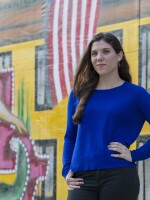The Tom and Mary James Museum for Western and Wildlife Art opens Saturday in downtown St. Petersburg. WUSF has a preview of what visitors can expect.
Click here to listen to the story.
When you enter the James Museum you are immediately transported from the urban downtown to an abstract Western world. Sandstone juts out on all sides, creating the feeling you're walking through a canyon, as you hear the light rush of a granite waterfall that serves as the lobby's backdrop.
There are a number of bronze sculptures in the lobby and along the staircases leading up to the main galleries. There are over 400 works in the museum, all from the James’ private collection, which includes about 3,000 pieces.
Museum Curator Emily Kapes says the museum offers “surprises around every corner.”
“When you think about Western art, you might think about bucking broncos and some traditional subjects, but we have it in all different styles,” she said. “So there is a lot of traditional work that is realistic, it’s really representational; but we also have pop art, surreal paintings, we have art related more to cubism and other art movements that have influenced the artists’ work.”
The museum also features a number of works by Native American artists, including a display of hand-crafted jewelry by Native American designers.
Museum founder and former chairman of Raymond James Financial Tom James says he has developed a nuanced interest in Western art over the years.

“I had an interest in it because of what I learned in fairy tales and Western movies,” he said. “Then when I learned about the history, often from Native Americans themselves, and the pieces of art they created and why they created it in the way they did to tell their story, I started worrying about what we as Americans and our forefathers did when they had westward expansion and continued to break every treaty they ever made with the Native Americans in the United States.”
James says he plans to use the institution to teach people about how the Western movement is connected to Native American cultures.
“Some of them right here in Florida 12,000 years ago,” he said. “So you think about those kinds of things and you realize there are a lot of stories to tell. We don’t do as good a job at telling (our kids) the stories that they ought to know about the history of our country and the lessons that many of us have learned over time, not just from history books, but from visiting different sites and talking to people about their backgrounds.”
In addition to educating the public, James wants to use the museum to highlight rising artists. He says the art is more meaningful to him when he has a relationship with the person who created it.
About 80 percent of the pieces in the museum collection were created by artists still alive today. There will also be a rotating exhibit featuring young artists – even those who don’t produce Western or wildlife art.
"We're trying to help talented young artists make a living in fine art," James said.
James says he views his museum as an important part of a cluster of arts destinations in St. Petersburg like the Chihuly Collection, the Museum of Fine Arts, the Dali Museum and the Museum of the American Arts and Crafts Movement, which is scheduled to open next year.
This weekend marks the James Museum’s soft opening. There will be a grand opening ceremony April 28-29.
Visit the museum website for more information on admission and exhibitions.













Copyright 2018 WUSF Public Media - WUSF 89.7

